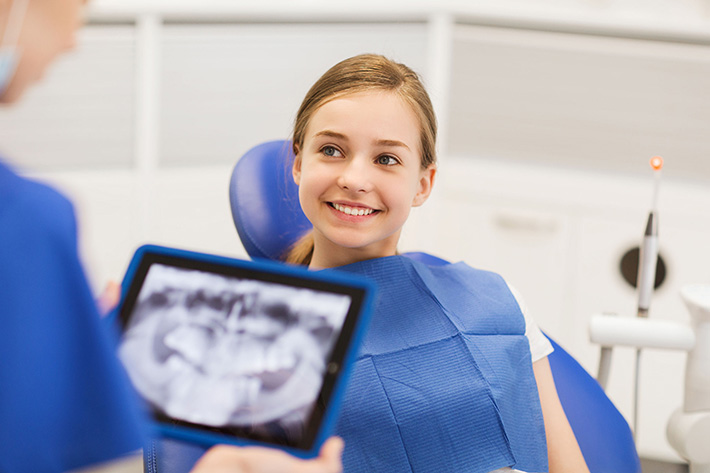When a dental professional drapes your child in a lead apron and puts a protective lead collar on their neck, most parents experience a moment of concern, wondering if dental x-rays are safe for their child. After all, we know that exposure to excessive amounts of radiation is linked to cancer. Rest assured that the protection afforded your child is standard procedure even though infrequent dental x-rays pose little risk to children.
In fact, dental x-rays are a valuable tool that dentists use in diagnosing and treating issues at an early stage, when the treatment is usually far less involved for the child.
We can’t avoid radiation in our daily lives. According to the United States Nuclear Regulatory Commission (NRC), a single exposure dental x-ray provides a 1.5 millirem dose of radiation. 1 According to the NRC, we get radiation from plants, animals and even water, which results in the average person receiving an average internal dose of about 30 millirem per year from the food and water we eat and drink.2 In fact, most of us will get an average dose of radiation from our environment that totals about 360 millirem each year.3
Other sources of radiation in our daily lives include cell phones, televisions, and even natural gas, but radiation exposure from these sources is very low. When a set of four bitewing X-rays are taken, the total amount of radiation is less than the average daily dose of radiation in everyday life.4
The National Academy of Sciences concludes that low doses of radiation from medical and dental X-rays, natural and other manmade sources pose some risk for cancer but that risk is small and shouldn’t keep people from seeking care.5 The American Dental Association (ADA) released guidelines regarding X-rays in 2012 which dentists use, along with their professional judgement, to decide when children need X-rays.
The ADA outlines many possible clinical scenarios where dental x-rays for children help dentists see issues that they can’t see during an examination. Some of the most common scenarios include revealing cavities between and on the teeth; finding familial dental anomalies that may be present; determining the cause of oral swelling; determine the impact of teeth that may be unerupted; finding teeth that have bone loss or periodontal disease; and visualizing teeth that are malposed or impacted.6
The American Academy of Pediatric Dentistry (AAPD) is also supportive of children receiving dental x-rays when warranted. In their brochure, Ask Your Dentist About X-Ray Use and Safety,7 they recommend that after a dentist reviews your child’s medical and dental histories, and conducts a clinical examination, dental x-rays should be done if your dentist deems them necessary.
The AAPD brochure further states that children actually need dental x-rays more frequently than adults, as their mouths grow and change rapidly and they are more susceptible than adults to tooth decay. For children with a high risk of tooth decay, the AAPD recommends X-rays every six months, while children with less risk should be x-rayed less frequently.
The bottom line is that the benefits of dental x-rays for children far outweigh the risks. Parents should inform their dentist, however, if their child has been exposed to radiation from other medical testing, such as CT scans and other medical x-rays. Today’s digital x-ray technology requires less radiation to capture a high-resolution image than traditional X-rays used decades ago. But, it is still important for parents to talk with their dentist about any concerns or questions they might have regarding x-ray safety and why x-rays are necessary.
Sedki Dentistry is committed to creating a healthy mouth and smile to last a lifetime. Early dental care is the foundation to a child’s oral health and Dr. Sedki and his caring staff will create a path of instilling the importance of good oral hygiene practices and preventative care. Using the latest technology and techniques to detect early tooth decay and various dental health issues, your child will receive the best possible dental care possible. Call today and schedule a dental checkup beginning with a Free consult!
___________________
1,2,3 Doses in Our Daily Lives, U.S. Nuclear Regulatory Commission
Link: https://www.nrc.gov/about-nrc/radiation/around-us/doses-daily-lives.html
4 How Much Radiation Do I Get From a Dental X-ray?
Link: https://www.koiscenter.com/patient-education/miscellaneous/how-much-radiation-do-i-get-from-a-dental-x-ray/
5 Benefits of X-Rays Outweigh Risks
Link: https://www.colgate.com/en-us/oral-health/procedures/x-rays/ada-07-x-ray-safety
6 X-Rays for Children, by Jennifer Mitchell, www.colgate.com
Link: https://www.colgate.com/en-us/oral-health/procedures/x-rays/x-rays-for-children
7 Ask Your Dentist About X-Ray Use and Safety, American Academy of Pediatric Dentistry
Link: https://digital.ipcprintservices.com/publication/?m=17256&l=1#{“issue_id”:64424,”page”:0}

